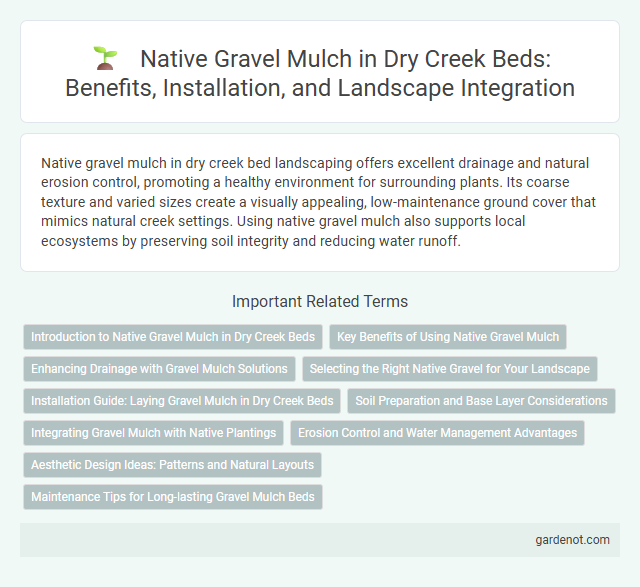Native gravel mulch in dry creek bed landscaping offers excellent drainage and natural erosion control, promoting a healthy environment for surrounding plants. Its coarse texture and varied sizes create a visually appealing, low-maintenance ground cover that mimics natural creek settings. Using native gravel mulch also supports local ecosystems by preserving soil integrity and reducing water runoff.
Introduction to Native Gravel Mulch in Dry Creek Beds
Native gravel mulch in dry creek beds provides natural erosion control by stabilizing soil and facilitating water drainage. This mulch type mimics the natural environment, promoting native plant growth while reducing weed proliferation. Its durability and permeability make it ideal for sustainable landscaping in arid or drought-prone regions.
Key Benefits of Using Native Gravel Mulch
Native gravel mulch enhances soil moisture retention by reducing evaporation, promoting healthier plant growth in dry creek beds. Its natural composition improves drainage, preventing waterlogging and soil erosion during heavy rains. Additionally, native gravel mulch suppresses weed growth, reducing maintenance efforts and preserving the natural ecosystem.
Enhancing Drainage with Gravel Mulch Solutions
Native gravel mulch improves drainage by allowing water to percolate quickly through the soil, reducing surface runoff and preventing erosion in dry creek beds. Its coarse texture creates air pockets that enhance soil aeration and promote healthy root growth for surrounding vegetation. Gravel mulch also stabilizes the creek bed, minimizing sediment displacement during heavy rainfall events.
Selecting the Right Native Gravel for Your Landscape
Selecting the right native gravel mulch for your dry creek bed involves choosing materials with appropriate size, color, and texture to complement the natural landscape and enhance water drainage. Opt for locally sourced gravel varieties such as quartz, granite, or basalt, which offer durability and blend seamlessly with the surrounding environment. Properly graded gravel ensures effective erosion control while providing an aesthetically pleasing, low-maintenance ground cover.
Installation Guide: Laying Gravel Mulch in Dry Creek Beds
To install native gravel mulch in dry creek beds, start by preparing the area through thorough clearing of debris and leveling the surface for optimal drainage. Next, lay a durable landscape fabric to prevent weed growth while allowing water permeation before evenly spreading a 2 to 3-inch layer of native gravel mulch. Compact the gravel gently to ensure stability and enhance the natural appearance, promoting effective erosion control and water runoff management.
Soil Preparation and Base Layer Considerations
Native gravel mulch enhances soil drainage and reduces erosion when applied over a well-prepared dry creek bed base. Proper soil preparation involves removing debris, leveling the surface, and ensuring a compacted subgrade to prevent settling. A stable base layer of permeable fabric beneath the gravel mulch promotes water infiltration and inhibits weed growth, optimizing the creek bed's functionality and aesthetics.
Integrating Gravel Mulch with Native Plantings
Integrating native gravel mulch with native plantings enhances soil moisture retention and reduces erosion in dry creek beds, creating a naturalistic landscape that supports local ecosystems. Gravel mulch provides excellent drainage while maintaining root health, promoting the growth of drought-tolerant native species such as manzanita, ceanothus, and sagebrush. This combination stabilizes creek beds, minimizes weed growth, and contributes to sustainable water conservation practices in arid environments.
Erosion Control and Water Management Advantages
Native gravel mulch in dry creek beds enhances erosion control by stabilizing soil and preventing runoff during heavy rains. Its porous structure promotes efficient water infiltration, reducing surface water accumulation and supporting groundwater recharge. This natural mulch also minimizes water evaporation, maintaining soil moisture and improving overall water management in arid landscapes.
Aesthetic Design Ideas: Patterns and Natural Layouts
Native gravel mulch enhances dry creek bed designs by creating visually appealing patterns such as waves, ripples, or concentric circles that mimic natural water flow. Utilizing varied gravel sizes and earth tones emphasizes texture and depth, blending seamlessly with native plants and rocks. Arranging gravel in organic, asymmetrical layouts supports a naturalistic aesthetic while improving drainage and soil protection.
Maintenance Tips for Long-lasting Gravel Mulch Beds
Native gravel mulch requires minimal upkeep, but occasional raking helps prevent weed growth and maintains an even surface. Applying a weed barrier fabric beneath the gravel mulch extends the bed's longevity by reducing invasive plants. Regularly topping up gravel every 1-2 years preserves its appearance and functionality in dry creek bed landscaping.
Native gravel mulch Infographic

 gardenot.com
gardenot.com